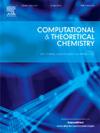Exploring the ground and low-lying excited states of gatifloxacin
IF 3
3区 化学
Q3 CHEMISTRY, PHYSICAL
引用次数: 0
Abstract
In this work, we present an investigation on the photoinduced degradation of the micropollutant gatifloxacin (GFX). Ground state properties (such as bond lengths, hydrogen-bond interactions, and relative energies) for one protonated and two deprotonated forms of the compound were determined through the use of the density functional theory (DFT), while time-dependent DFT (TD-DFT) was used for probing their excited state parameters (vertical excitation energies, oscillator strengths — OS, and structures). The CAM-B3LYP, M06-2X, and LC-PBE exchange–correlation functionals were employed along with the 6-311+G(d,p), 6-311++G(d,p), def2-TZVP, and aug-cc-pVTZ basis sets. Solvent effects were incorporated with the polarizable continuum model. Considering the parent GFX molecule as instance, all the results for its ground state computed using the CAM-B3LYP exchange–correlation functional with a given basis set were found to be in excellent agreement to those corresponding determined using the M06-2X along with any of the basis sets used; excellent agreement was also observed in the case of the excited state properties. Three states (S1, S4, and S5) were probed to be likely accessible among the five lowest-lying excited singlets, with S1 being determined at 4.22 eV with OS = 0.1159, S4 at 4.60 eV with OS = 0.7243, and S5 at 4.94 eV with OS = 0.1672, at the CAM-B3LYP/6-311+G(d,p) level of theory in water, for example. These results were used for establishing a correlation with the findings presented in previous (recent) experimental work involving the photoinduced degradation of the GFX molecule. In this sense, S1 was assigned as the excited state connected to the degradation path of the GFX molecule when irradiated with the UVA light while the existence of two additional excited singlet states with non-zero OS (S4 and S5, with S4 having a considerably large OS) was associated to the faster degradation provided by the more energetic UVC when compared to the UVA radiation. In addition, the excited state structures suggested GFX as undergoing photodecomposition (chemical reactions occurring in the excited state) rather than direct photolysis when irradiated with UVA and UVC light.

探索加替沙星的地面和低洼激发态
本文对微污染物加替沙星(GFX)的光诱导降解进行了研究。通过使用密度泛函理论(DFT)确定了一种质子化形式和两种去质子化形式的化合物的基态性质(如键长、氢键相互作用和相对能量),而时间依赖的DFT (TD-DFT)用于探测它们的激发态参数(垂直激发能、振荡器强度- OS和结构)。CAM-B3LYP、M06-2X和LC-ωPBE交换相关泛函与6-311+G(d,p)、6-311++G(d,p)、def2-TZVP和8 -cc- pvtz基集一起使用。溶剂效应与极化连续介质模型相结合。以母体GFX分子为例,使用给定基集的CAM-B3LYP交换相关函数计算其基态的所有结果都与使用M06-2X以及所使用的任何基集确定的相应结果非常一致;在激发态性质的情况下也观察到极好的一致性。在5个最低的激发单重态中,S1、S4和S5可能被探测到,其中S1在4.22 eV, OS = 0.1159, S4在4.60 eV, OS = 0.7243, S5在4.94 eV, OS = 0.1672,例如在水中的am - b3lyp /6-311+G(d,p)理论水平。这些结果用于建立与先前(最近)涉及GFX分子光诱导降解的实验工作中提出的发现的相关性。在这个意义上,S1被指定为与GFX分子在UVA光照射下的降解路径相连的激发态,而另外两个具有非零OS的激发态(S4和S5,其中S4具有相当大的OS)的存在与更高能量的UVC比UVA辐射提供更快的降解有关。此外,激发态结构表明,当UVA和UVC光照射时,GFX发生了光分解(在激发态下发生的化学反应),而不是直接光解。
本文章由计算机程序翻译,如有差异,请以英文原文为准。
求助全文
约1分钟内获得全文
求助全文
来源期刊

Computational and Theoretical Chemistry
CHEMISTRY, PHYSICAL-
CiteScore
4.20
自引率
10.70%
发文量
331
审稿时长
31 days
期刊介绍:
Computational and Theoretical Chemistry publishes high quality, original reports of significance in computational and theoretical chemistry including those that deal with problems of structure, properties, energetics, weak interactions, reaction mechanisms, catalysis, and reaction rates involving atoms, molecules, clusters, surfaces, and bulk matter.
 求助内容:
求助内容: 应助结果提醒方式:
应助结果提醒方式:


